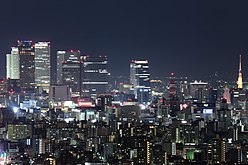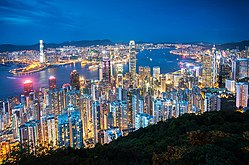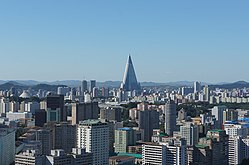East Asia
4th) | |
| Population density | 141.9 km2 (54.8 sq mi) |
|---|---|
| GDP (PPP) | $44.7 trillion (2023)[1] |
| GDP (nominal) | $24.8 trillion (2023)[1] |
| GDP per capita | $15,000 (nominal)[1] |
| Demonym | East Asian |
| Countries | |
| Dependencies | |
| Languages | |
| Time zones | |
| UN M49 code | 030 – Eastern Asia142 – Asia001 – World |
| East Asia | |||||||
|---|---|---|---|---|---|---|---|
| Chinese name | |||||||
Mongolian Cyrillic | Зүүн Ази ᠵᠡᠭᠦᠨ ᠠᠽᠢ | ||||||
| |||||||
| Japanese name | |||||||
| Kana | ひがしアジア/とうあ | ||||||
| Kyūjitai | 東亞細亞/東亞 | ||||||
| Shinjitai | 東亜細亜(東アジア)/東亜 | ||||||
| |||||||
| Uyghur name | |||||||
| Uyghur | شەرقىي ئاسىي | ||||||
| |||||||
East Asia is a region of Asia, which is defined in both geographical and ethno-cultural terms.[7][8] The modern states of East Asia include China, Japan, Mongolia, North Korea, South Korea, and Taiwan.[2][3][4][5] Hong Kong and Macau, two coastal cities located in the south of China, are autonomous regions under Chinese sovereignty. The economies of Japan, South Korea, China, Taiwan, Hong Kong, and Macau are some of the world's largest and most prosperous economies.[9] East Asia borders Siberia and the Russian Far East to the north, Southeast Asia to the south, South Asia to the southwest, and Central Asia to the west. To the east is the Pacific Ocean and to the southeast is Micronesia (a Pacific Ocean island group that is classified as part of Oceania).
East Asia, especially
Major
History
China was the first region settled in East Asia and was undoubtedly the core of East Asian civilization from where other parts of East Asia were formed.[22] The various other regions in East Asia were selective in the Chinese influences they adopted into their local customs. Historian Ping-ti Ho famously labeled Chinese civilization as the "Cradle of Eastern Civilization", in parallel with the "Cradle of Middle Eastern Civilization" along the Fertile Crescent encompassing Mesopotamia and Ancient Egypt[23] as well as the Cradle of Western Civilization encompassing Ancient Greece[a] and Ancient Rome.[b]


Chinese civilization existed for about 1,500 years before other East Asian civilizations emerged into history, Imperial China would exert much of its cultural, economic, technological, and political muscle onto its neighbours.[39][40][41][42] Succeeding Chinese dynasties exerted enormous influence across East Asia culturally, economically, politically and militarily for over two millennia.[42][43][44] The Imperial Chinese tributary system shaped much of East Asia's history for over two millennia due to Imperial China's economic and cultural influence over the region, and thus played a huge role in the history of East Asia in particular.[45][46][41] Imperial China's cultural preeminence not only led the country to become East Asia's first literate nation in the entire region, it also supplied Japan and Korea with Chinese loanwords and linguistic influences rooted in their writing systems.[47]
Under
As full-fledged medieval East Asian states were established, Korea by the fourth century AD and Japan by the seventh century AD, Japan and Korea actively began to incorporate Chinese influences such as Confucianism, the use of written Han characters, Chinese style architecture, state institutions, political philosophies, religion, urban planning, and various scientific and technological methods into their culture and society through direct contacts with Tang China and succeeding Chinese dynasties.[54][55][58] Drawing inspiration from the Tang political system, Prince Naka no oe launched the Taika Reform in 645 AD where he radically transformed Japan's political bureaucracy into a more centralised bureaucratic empire.[59] The Japanese also adopted Mahayana Buddhism, Chinese style architecture, and the imperial court's rituals and ceremonies, including the orchestral music and state dances had Tang influences. Written Chinese gained prestige and aspects of Tang culture such as poetry, calligraphy, and landscape painting became widespread.[59] During the Nara period, Japan began to aggressively import Chinese culture and styles of government which included Confucian protocol that served as a foundation for Japanese culture as well as political and social philosophy.[60][61] The Japanese also created laws adopted from the Chinese legal system that was used to govern in addition to the kimono, which was inspired from the Chinese robe (hanfu) during the eighth century AD.[62] For many centuries, most notably from the 7th to the 14th centuries, China stood as East Asia's most advanced civilization and foremost military and economic power, exerting its influence as the transmission of advanced Chinese cultural practices and ways of thinking greatly shaped the region up until the nineteenth century.[63][64][65][66]
As East Asia's connections with Europe and the Western world strengthened during the late nineteenth century, China's power began to decline.
Definitions
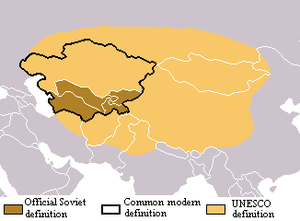
In common usage, the term "East Asia" typically refers to a region including Greater China, Japan, Korea and Mongolia.[83][90][91][92][93][94][95][96][97][98]
Broader and looser definitions by international agencies and organisations such as the

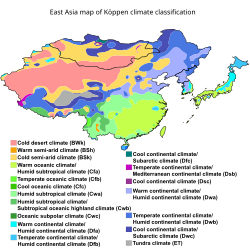
The UNSD definition of East Asia is based on statistical convenience,[118] but others commonly use the same definition of Mainland China, Hong Kong, Macau, Mongolia, North Korea, South Korea, Taiwan, and Japan.[7][119]
Certain Japanese islands are associated with Oceania due to non-continental geology, distance from mainland Asia or biogeographical similarities with Micronesia.[120][121] Some groups, such as the World Health Organization, categorize China, Japan and Korea with Australia and the rest of Oceania. The World Health Organization label this region the "Western Pacific", with East Asia not being used in their concept of major world regions. Their definition of this region further includes Mongolia and the adjacent area of Cambodia, as well as the countries of the South East Asia Archipelago (excluding East Timor and Indonesia).[122]
Alternative definitions
In business and economics, "East Asia" is sometimes used to refer to the geographical area covering ten
Observers preferring a broader definition of "East Asia" often use the term Northeast Asia to refer to China, the Korean Peninsula, and Japan, with Southeast Asia covering the ten ASEAN countries. This usage, which is seen in economic and diplomatic discussions, is at odds with the historical meanings of both "East Asia" and "Northeast Asia".[124][125][126] The Council on Foreign Relations of the United States defines Northeast Asia as Japan and Korea.[115]
Economy
| Customs territory | GDP nominal billions of USD (2023)[1] |
GDP nominal per capita USD (2023)[1] |
GDP PPP billions of USD (2023)[1] |
GDP PPP per capita USD (2023)[1] |
|---|---|---|---|---|
| 17,700,899 | 12,541 | 32,897,929 | 23,309 | |
| 385,546 | 51,168 | 548,999 | 72,861 | |
| 38,480 | 54,296 | 69,565 | 98,157 | |
| 4,230,862 | 33,950 | 6,495,214 | 52,120 | |
| 18,782 | 5,348 | 52,989 | 15,088 | |
| N/A | N/A | N/A | N/A | |
| 1,709,232 | 33,147 | 2,924,189 | 56,709 | |
| 751,930 | 32,339 | 1,685,358 | 72,485 | |
| East Asia | $24,835,731 | $15,068 | $44,674,243 | $27,104 |
Territorial and regional data
China, North Korea, South Korea and Taiwan are all unrecognised by at least one other East Asian state because of severe ongoing political tensions in the region, specifically the division of Korea and the political status of Taiwan.
Etymology
| Flag | Common Name | Official name | ISO 3166 Country Codes[127] | |||||
|---|---|---|---|---|---|---|---|---|
Exonym |
Endonym |
Exonym |
Endonym |
ISO Short Name | Alpha-2 Code | Alpha-3 Code | Numeric | |
| China | 中国 | People's Republic of China | 中华人民共和国 | China | CN | CHN | 156 | |
| Hong Kong | 香港 | Hong Kong Special Administrative Region of the People's Republic of China |
中華人民共和國香港特別行政區 | Hong Kong | HK | HKG | 344 | |
| Macau | 澳門 | Macao Special Administrative Region of the People's Republic of China |
中華人民共和國澳門特別行政區 | Macao | MO | MAC | 446 | |
| Japan | 日本 | Japan | 日本国 | Japan | JP | JPN | 392 | |
| Mongolia | Монгол улс / ᠮᠣᠩᠭᠣᠯ ᠤᠯᠤᠰ |
Mongolia | Монгол Улс (ᠮᠣᠩᠭᠣᠯ ᠤᠯᠤᠰ) |
Mongolia | MN | MNG | 496 | |
| North Korea | 조선 | Democratic People's Republic of Korea | 조선민주주의인민공화국 | Korea (the Democratic People's Republic of) | KP | PRK | 408 | |
| South Korea | 한국 | Republic of Korea | 대한민국 | Korea (the Republic of) | KR | KOR | 410 | |
| Taiwan[f] | 臺灣 / 台灣 | Republic of China | 中華民國 | Taiwan[127] | TW | TWN | 158 | |
Demographics
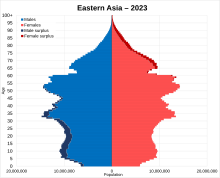
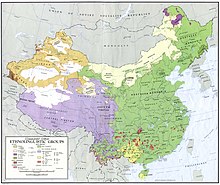
| State/Territory | Area km2
|
Population in
|
% of East Asia | % of World | Population density per km2 |
HDI[130] | Capital/Administrative Centre
|
|---|---|---|---|---|---|---|---|
| 9,640,011[g] | 1,425,671[h] | 85.76% | 17.72% | 138 | 0.768 | Beijing | |
| 1,104 | 7,492 | 0.45% | 0.093% | 6,390 | 0.952 | Hong Kong | |
| 30 | 704 | 0.042% | 0.0087% | 18,662 | 0.922 | Macao
| |
| 377,930 | 123,295 | 7.42% | 1.53% | 337 | 0.925 | Tokyo | |
| 1,564,100 | 3,447 | 0.2% | 0.042% | 2 | 0.739 | Ulaanbaatar | |
| 120,538 | 26,161 | 1.57% | 0.33% | 198 | 0.733[citation needed] | Pyongyang[i] | |
| 100,210 | 51,784 | 3.11% | 0.64% | 500 | 0.925 | Seoul | |
| 36,197 | 23,923 | 1.44% | 0.297% | 639 | 0.926 | Taipei[j] | |
| East Asia | 11,840,000 | 1,662,477 | 100% | 20.66% | 141 |
Ethnic groups
| Ethnicity | Native name | Population | Language(s) | Writing system(s) | Major states/territories* | Traditional attire |
|---|---|---|---|---|---|---|
| Han/Chinese | 漢族 or 汉族 | 1,313,345,856[134] | Chinese (Mandarin, Min, Wu, Yue, Jin, Gan, Hakka, Xiang, Huizhou, Pinghua, etc.) | Traditional Han characters
|

| |
| Yamato/Japanese | 大和民族 | 125,117,000[135] | Japanese | Han characters (Kanji), Katakana, Hiragana | 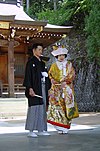
| |
Korean
|
조선민족 (朝鮮民族) 한민족 (韓民族) |
84,790,105[136][137][138] | Korean | Hangul, Han characters (Hanja) | 
| |
| Bai | 白族 | 2,091,543[139] | Bai, Southwestern Mandarin | Simplified Han characters, Latin script | 
| |
| Hui | 回族 | 11,377,914[139] | Huihui language , etc.
|
Simplified Han characters[k] | 
| |
Mongols
|
Монголчууд ᠮᠣᠩᠭᠣᠯᠴᠤᠳ Монгол/ᠮᠣᠩᠭᠣᠯ |
8,942,528 | Mongolian | Mongol script, Cyrillic script
|

| |
| Zhuang | 壮族/Bouxcuengh | 19,568,546[139] | Zhuang, Southwestern Mandarin, etc. | Simplified Han characters, Latin script | 
| |
| Uyghurs | 维吾尔族/ئۇيغۇر | 11,774,538[139] | Uyghur | Arabic alphabet, Latin script | 
| |
Manchus
|
满族/ᠮᠠᠨᠵᡠ | 10,423,303[139] | Northeastern Mandarin, Manchu language | Simplified Han characters, Mongol script | 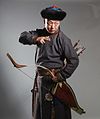
| |
| Hmong/Miao | 苗族/Ghaob Xongb/Hmub/Mongb | 11,067,929[139] | Hmong/Miao, Southwestern Mandarin | Latin script, Simplified Han characters | 
| |
Tibetans
|
藏族/བོད་པ་ | 7,060,731[139] | Tibetan, Rgyal Rong, Rgu, etc. | Tibetan script | 
| |
| Yi | 彝族/ꆈꌠ | 9,830,327[139] | Various Loloish, Southwestern Mandarin | Yi script, Simplified Han characters | 
| |
| Tujia | 土家族 | 9,587,732[139] | Northern Tujia, Southern Tujia | Simplified Han characters | 
| |
| Kam | 侗族/Gaeml | 3,495,993[139] | Gaeml | Simplified Han characters, Latin script | 
| |
Tu
|
土族/Monguor | 289,565 | Tu, Northwestern Mandarin | Simplified Han characters | 
| |
| Daur | 达斡尔族/ᠳᠠᠭᠤᠷ | 131,992 | Daur , Northeastern Mandarin
|
Mongol script, Simplified Han characters | 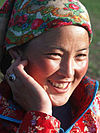
| |
Indigenous Taiwanese Peoples
|
臺灣原住民/ 高山族/ Yincomin/ Kasetaivang/ Inanuwayan | 533,600 | Austronesian languages (Amis, Yami), etc. | Latin script, Traditional Han characters | ||
| Ryukyuan | 琉球民族 | 1,900,000 | Japanese Ryukyuan |
Han characters (Kanji), Katakana, Hiragana | 
| |
| Ainu | アイヌ/ Aynu/ Айну | 200,000 | Japanese Ainu[140] |
Han characters (Kanji), Katakana, Hiragana | 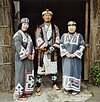
|
- Note: The order of states/territories follows the population ranking of each ethnicity, within East Asia only.
East Asian culture
Overview
The culture of East Asia has largely been
Religions
Religion in East Asia (2020)[150]
| Religion | Native name | Creator/Current Leader | Founded Time | Main Denomination | Major book | Type | Est. Followers | Ethnic groups | States/territories |
|---|---|---|---|---|---|---|---|---|---|
| Chinese folk religion | 中國民間信仰 or 中国民间信仰 | Spontaneous formation | Prehistoric period | Salvationist, Wuism, Nuo | Chinese classics, Huangdi Sijing, precious scrolls, etc. | Prehistoric, pantheism, and polytheism | ~900,000,000[151][152] | Han, Hmong, Qiang, Tujia (worship of the same ancestor-gods) | |
| Taoism | 道教 | Zhang Daoling, Wang Chongyang (Quanzhen School) | 125 AD Eastern Han dynasty[citation needed ]
|
Zhengyi, Quanzhen | Tao Te Ching | Pantheism, polytheism | ~20,000,000[152] | Han, Zhuang, Hmong, Yao, Qiang, Tujia | |
| East Asian Buddhism/Chinese Buddhism | 漢傳佛教 or 汉传佛教 | King Seong of Baekje (introduced to Japan)
|
67 AD Eastern Han dynasty
|
Mahayana | Diamond Sutra | Non-God, Dualism. | ~300,000,000 | Han, Koreans, Yamato | |
| Tibetan Buddhism | 藏传佛教/བོད་བརྒྱུད་ནང་བསྟན། | Tonpa Shenrab Miwoche | 1800 years ago | Mahayana, Bon | Anuttarayoga Tantra
|
Non-God | ~10,000,000 | Tibetans, Manchus, Mongols | |
| Shamanism[m] | 萨满教 or Бөө мөргөл | Spontaneous formation | Prehistoric period | N/A | Prehistoric, polytheism, and pantheism | N/A | Manchus, Mongols, Oroqens | ||
| Shinto | 神道 | Spontaneous formation | Yayoi period[153] | Shinto sects | Kojiki, Nihon Shoki | Prehistoric, pantheism, and polytheism | N/A | Yamato | |
Musok/Muism
|
신도 or 무교 | Spontaneous formation | 900 years ago[citation needed] | Musok sects | N/A | Prehistoric, pantheism, and polytheism | N/A | Koreans | |
| Ryukyuan religion | 琉球神道 or ニライカナイ信仰 | Spontaneous formation | N/A | N/A | N/A | Prehistoric, pantheism, and polytheism | N/A | Ryukyuans |
Festivals
| Festival | Native Name | Other name | Calendar | Date | Gregorian date | Activity | Religious practices | Food | Major ethnicities | Major states/territories |
|---|---|---|---|---|---|---|---|---|---|---|
| Chinese New Year | 農曆新年/农历新年 or 春節/春节 | Spring Festival | Chinese | Month 1 Day 1 | 21 Jan–20 Feb | Family Reunion, Ancestors Worship, Tomb Sweeping, Fireworks | Worship the King of Gods | Nian gao | Han, Manchus etc. | |
| Korean New Year | 설날 or 설 | Seollal | Korean | Month 1 Day 1 | 21 Jan–20 Feb | Ancestors Worship, Family Reunion, Tomb Sweeping | N/A | Tteokguk | Koreans | |
| Losar or Tsagaan Sar | 藏历新年/ལོ་གསར་ or 查干萨日/Цагаан сар | White Moon | Tibetan, Mongolian | Month 1 Day 1 | 25 Jan – 2 Mar | Family Reunion, Ancestors Worship, Tomb Sweeping, Fireworks | N/A | Chhaang or Buuz | Tibetans, Mongols, Tu etc.
|
|
| New Year | 元旦 | Yuan Dan | Gregorian | 1 Jan | 1 Jan | Fireworks | N/A | N/A | N/A | |
| Lantern Festival | 元宵節 or 元宵节 | Upper Yuan Festival (上元节) | Chinese | Month 1 Day 15 | 4 Feb – 6 Mar | Lanterns Expo, Ancestors Worship, Tomb Sweeping | Birthdate of the God of Sky-officer | Yuanxiao | Han | |
| Daeboreum | 대보름 or 정월 대보름 | Great Full Moon | Korean | Month 1 Day 15 | 4 Feb – 6 Mar | Greeting of the moon, kite-flying, Jwibulnori, eating nuts (Bureom) | Bonfires (daljip taeugi) | Ogok-bap, namul, nuts | Korean | |
| Hanshi Festival | 寒食節 or 寒食节 | Cold Food Festival | Solar term | Traditionally, on the 105th day after the Winter solstice. Revised to 1 day before the Qingming Festival by Johann Adam Schall von Bell (Chinese: 汤若望) during the Qing dynasty. | April 3–5 | Ancestors Worship, Tomb Sweeping, No cooking hot meal/setting fire, Cold food only. Cuju, etc. (People used to mix this one with the Qingming Festival due to their close dates) | In Memory of a loyal Ancient named Jie Zhitui (Chinese: 介子推), ordered by the Monarch of the Jin (Chinese state), Duke Wen of Jin (Chinese: 重耳) | Cold Food, e.g. Qingtuan | Han, Koreans, Mongols | |
| Qingming Festival | 清明節 or 清明节 or Ханш нээх | Tomb Sweeping Day | Solar term | 15th day after the Vernal Equinox. Just 1 day after the Hanshi Festival, but in much higher repute. | April 4-6th | Ancestors Worship, Tomb Sweeping, Excursion, Planting trees, Flying kites, Tug of war, Cuju, etc. (Almost the same with the Hanshi Festival's, due to their close dates) | Burning Hell money for deceased family members. Planting willow branches to keep ghosts away from houses. | Boiled eggs | Han, Koreans, Mongols | |
| Dragon Boat Festival | 端午節 or 端午节 or 단오 | Duanwu Festival / Dano (Surit-nal)
|
Chinese / Korean | Month 5 Day 5 | Driving poisons & plague away. (China - Dragon Boat Race, Wearing coloured lines, Hanging felon herb on the front door.) / (Korea - Washing hair with iris water, ssireum) | Worship various Gods | Zongzi / Surichwitteok (rice cake with herbs) | Han, Koreans, Yamato | ||
| Ghost Festival | 中元節 or 中元节 or 백중 | Mid Yuan Festival | Chinese | Month 7 Day 15 | Ancestors Worship, Tomb Sweeping | Birthdate of the God of Earth-officer | Han, Koreans, Yamato | |||
| Mid-Autumn Festival | 中秋節 or 中秋节 | 中秋祭 | Chinese | Month 8 Day 15 | Family Reunion, Enjoying Moon view | Worship the Moon Goddess | Mooncake | Han | ||
| Chuseok | 추석 or 한가위 | Hangawi | Korean | Month 8 Day 15 | Family Reunion, Ancestors Worship, Tomb Sweeping, Enjoying Moon view | N/A | Songpyeon, Torantang (Taro soup) | Koreans | ||
| Tsukimi | 月見 or お月見 | Tsukimi or Otsukimi | Gregorian
|
Month 8 Day 15 | Family Reunion, Enjoying Moon view | Worship the Moon | Sweet Potato
|
Yamato | ||
| Double Ninth Festival | 重陽節 or 重阳节 | Double Positive Festival | Chinese | Month 9 Day 09 | Climbing Mountain, Taking care of elderly, Wearing Cornus. | Worship various Gods | Han, Korean, Yamato | |||
| Lower Yuan Festival | 下元節 or 下元节 | N/A | Chinese | Month 10 Day 15 | Ancestors Worship, Tomb Sweeping | Birthdate of the God of Water-officer | Ciba | Han | ||
| Dongzhi Festival | 冬至 or 동지 or 冬至 | N/A | Gregorian | Between Dec 21 and Dec 23 | Between Dec 21 and Dec 23 | Ancestors Worship, Rites to dispel bad spirits | N/A | Zenzai, Kabocha
|
Han, Koreans, Yamato | |
| Small New Year | 小年 | Jizao (祭灶) | Chinese | Month 12 Day 23 | Cleaning Houses | Worship the God of Hearth | tanggua
|
Han, Mongols |
*Japan switched the date to the Gregorian calendar after the Meiji Restoration.
*Not always on that Gregorian date, sometimes April 4.
Collaboration
East Asian Youth Games
Formerly the East Asian Games, it is a multi-sport event organized by the East Asian Games Association (EAGA) and held every four years since 2019 among athletes from East Asian countries and territories of the Olympic Council of Asia (OCA), as well as the Pacific island of Guam, which is a member of the Oceania National Olympic Committees.
It is one of five Regional Games of the OCA. The others are the
Free trade agreements
| Name of agreement | Parties | Leaders at the time | Negotiation begins | Signing date | Starting time | Current status |
|---|---|---|---|---|---|---|
| China–South Korea FTA | Xi Jinping, Park Geun-hye | May, 2012 | Jun 01, 2015 | Dec 30, 2015 | Enforced | |
| China–Japan–South Korea FTA | Shinzō Abe, Park Geun-hye
|
Mar 26, 2013 | N/A | N/A | 10 round negotiation | |
| Japan-Mongolia EPA | Shinzō Abe, Tsakhiagiin Elbegdorj
|
- | Feb 10, 2015 | - | Enforced | |
| China-Mongolia FTA | Xi Jinping, Tsakhiagiin Elbegdorj | N/A | N/A | N/A | Officially proposed | |
| China-HK CEPA | Jiang Zemin, Tung Chee-hwa | - | Jun 29, 2003 | - | Enforced | |
| China-Macau CEPA | Jiang Zemin, Edmund Ho Hau-wah | - | Oct 18, 2003 | - | Enforced | |
| Hong Kong-Macau CEPA | Carrie Lam, Fernando Chui | Oct 09, 2015 | N/A | N/A | Negotiating | |
| ECFA | Hu Jintao, Ma Ying-jeou | Jan 26, 2010 | Jun 29, 2010 | Aug 17, 2010 | Enforced | |
| CSSTA (Based on ECFA) | Xi Jinping, Ma Ying-jeou | Mar, 2011 | Jun 21, 2013 | N/A | Abolished | |
| CSGTA (Based on ECFA) | Hu Jintao, Ma Ying-jeou | Feb 22, 2011 | N/A | N/A | Suspended |
Military alliances
Major cities
| Rank | City name | Country
|
Pop.
| ||||||
|---|---|---|---|---|---|---|---|---|---|
 Tokyo |
1 | Tokyo | Japan | 38,140,000 | |||||
| 2 | Seoul | South Korea | 25,520,000 | ||||||
| 3 | Shanghai | China | 24,484,000 | ||||||
| 4 | Beijing | China | 21,240,000 | ||||||
| 5 | Osaka | Japan | 20,337,000 | ||||||
| 6 | Chongqing | China | 13,744,000 | ||||||
| 7 | Guangzhou | China | 13,070,000 | ||||||
| 8 | Tianjin | China | 11,558,000 | ||||||
| 9 | Shenzhen | China | 10,828,000 | ||||||
| 10 | Chengdu | China | 10,104,000 | ||||||
-
metropolitan population and economy.
-
Beijing is the capital of China. It has a history for over 3300 years.
-
Seoul is the capital of South Korea.
-
Osaka is the second-largest metropolitan area in Japan.
-
Guangzhou is one of the most important economic centers in southern China.
-
Kyoto was the imperial capital of Japan for eleven centuries.
-
Ulaanbaatar is the capital of Mongolia, with a population of 1.6 million as of 2021.
-
Hong Kong is one of the global financial centres and is known as a cosmopolitan metropolis.
-
Korean Peninsula.
-
Pass of the ISS over Mongolia, looking out west towards the Pacific Ocean, China, and Japan. As the video progresses, major cities along the Chinese coast and the Japanese islands on the Philippine Sea are visible. The island of Guam can be seen further down the pass into the Philippine Sea, and the pass ends just to the east of New Zealand.
See also
- East Asia–United States relations
- East Asian Community
- East Asian languages
- China–Japan–South Korea trilateral summit
- East Asia Summit
- East Asian studies
- East Asian cultural sphere
Notes
- ^ See[24][25][26][27][28][29][30][31][32][33][34]
- ^ [35][36][37][38]
- ^ Listed as "Hong Kong SAR" by IMF
- ^ Listed as "Macao SAR" by IMF
- ^ Listed as "Taiwan, Province of China" by IMF
- ^ From 1949 to 1971, the ROC was referred as "China" or "Nationalist China".
- ^ Includes all area which under PRC's government control (excluding "South Tibet" and disputed islands).[citation needed]
- ^ A note by the United Nations: "For statistical purposes, the data for China do not include Hong Kong and Macao, Special Administrative Regions (SAR) of China, and Taiwan Province of China."[128][129]
- ^ Seoul was the de jure capital of the DPRK from 1948 to 1972.
- ^ Taipei is the ROC's seat of government by a decree thus making it the de facto capital. There is no official capital appointed by the ROC constitution.[131][132][133]
- ^ The Hui people also use the Arabic alphabet in the religious field.
- ^ The Khotons also in
 .
.
- ^ almost Manchu, Mongolian
References
- ^ a b c d e f g "World Economic Outlook Database, October 2023 Edition". International Monetary Fund. Retrieved 2023-10-25.
- ^ ISBN 978-0761326724.
- ^ a b "East Asia". rand.org. RAND Corporation. Archived from the original on 2011-01-02. Retrieved 12 August 2021.
- ^ German Federal Foreign Office. May 2002. Archived from the original(PDF) on 19 December 2021. Retrieved 12 August 2021.
- ^ a b "Countries of Asia". nationsonline.org. Nations Online. Archived from the original on 2001-07-01. Retrieved 12 August 2021.
- ^ "Demographia World Urban Areas" (PDF). Demographia.com. August 2023.
- ^ a b "East Asia". Encarta. Microsoft. Archived from the original on 2009-11-09. Retrieved 2008-01-12.
the countries and regions of Mainland China, Hong Kong, Macau, Taiwan, Mongolia, South Korea, North Korea and Japan.
- ISBN 978-0765618221.
- ^ "East Asia in the 21st Century | Boundless World History". courses.lumenlearning.com. Retrieved 2019-11-25.
- ISBN 978-0415636070.
- ISBN 978-1107544895.
- ISBN 978-1118624609.
- ISBN 978-9048162710.
- ISBN 9780965064750.
- ISBN 978-1412916882.
- ISBN 9780754631859.
- ^ Andreas Anangguru Yewangoe, "Theologia crucis in Asia", 1987 Rodopi
- ISBN 9780710306852.
- ISBN 978-1843391425.
- PMID 29636655.
- PMID 29636655.
- ISBN 978-1-4772-6517-8.
- ISBN 978-1-107-11873-7.
- ISBN 978-0-8239-3999-2.
- ISBN 978-0-313-32278-5.
- ISBN 9780943448114.
for ancient Greece was the cradle of Western culture ...
- ISBN 978-0-8264-6895-6.
Part I Pre-Socratic Philosophy Chapter II the Cradle of Western Thought:
- ISBN 978-88-8029-435-1.
The capital of Greece, one of the world's most glorious cities and the cradle of Western culture,
- ISBN 978-1-4438-3028-7.
In short, Greece, despite having been the cradle of Western culture, was then an "other" space separate from the West.
- ^ Library Journal. Vol. 97. Bowker. April 1972. p. 1588.
Ancient Greece: Cradle of Western Culture (Series), disc. 6 strips with 3 discs, range: 44–60 fr., 17–18 min
- ISBN 978-1-930053-10-6.
and making Egypt play the same role in African education and culture that Athens and Greece do in Western culture.
- ISBN 978-0-7456-8950-0.
Greece has long been considered the seedbed or cradle of Western civilization.
- ISBN 978-88-492-6909-3.
The Special Case of Greece The ancient Greece was a cradle of the Western culture,
- ISBN 978-1-4296-6831-6.
Ancient Greece is often called the cradle of western civilization. ... Ideas from literature and science also have their roots in ancient Greece.
- ISBN 9781177738538.
- ^ Michael Ed. Grant (1964). The Birth Of Western Civilisation, Greece & Rome. Thames & Hudson. Retrieved 4 January 2016 – via Amazon.co.uk.
- ^ HUXLEY, George; et al. "9780500040034: The Birth of Western Civilization: Greece and Rome". AbeBooks.com. Retrieved 4 January 2016.
- ^ "Athens. Rome. Jerusalem and Vicinity. Peninsula of Mt. Sinai.: Geographicus Rare Antique Maps". Geographicus.com. Retrieved 4 January 2016.
- ^ ISBN 978-0714646619.
- ^ Walker, Hugh Dyson (2012). East Asia: A New History. AuthorHouse. p. 119.
- ^ ISBN 978-1594205460.
- ^ ISBN 978-0231153195.
- ISBN 978-0415670029.
- ISBN 9783319718859.
- ISBN 978-0313336843.
- ^ ISBN 0231101082.
- ISBN 978-0521296533.
- ISBN 978-0231101080.
- ISBN 978-1400077410.
- ISBN 978-1610488853.
- ISBN 978-0765623287.
- ISBN 978-1425770495.
- ISBN 978-1425770495.
- ^ a b c Lockard, Craig (1999). "Tang Civilization and the Chinese Centuries" (PDF). Encarta Historical Essays: 2–3.
- ^ a b c Lockard, Craig (1999). "Tang Civilization and the Chinese Centuries" (PDF). Encarta Historical Essays: 7.
- ^ "Tang Dynasty – The Art of Asia – Chinese Dynasty Guide". archive.artsmia.org.
- ISBN 9781107098466– via Google Books.
- ISBN 978-0195076189.
- ^ a b Lockard, Craig (1999). "Tang Civilization and the Chinese Centuries" (PDF). Encarta Historical Essays: 8.
- ISBN 978-1-4390-8540-0.
- ISBN 9781563242656.
Japan culture tang dynasty.
- ISBN 978-1425770495.
- ISBN 978-1419648939.
- ^ Lind, Jennifer (February 13, 2018). "Life in China's Asia: What Regional Hegemony Would Look Like". Foreign Affairs. 97 (March/April 2018).
- ^ Lockard, Craig (1999). "Tang Civilization and the Chinese Centuries" (PDF). Encarta Historical Essays.
- ISBN 9781598841633.
- ISBN 0-19-511504-X.
- ISBN 978-0765617866.
- ISBN 978-0765617866.
- ^ ISBN 978-0393934083.
- ^ ISBN 978-0230001336.
- ISBN 978-0231101080.
- ^ a b c Batty, David (2005-01-17). Japan's War in Colour (documentary). TWI.
- ISBN 978-9712331244.
- ^ ISBN 978-0674000971.
- ISBN 978-0231101080.
- ISBN 978-0415737272.
- ISBN 978-0313350825.
- ^ "Sino-Japanese War (1894–95)". Encyclopædia Britannica. Retrieved 12 November 2012.
- ^ "The Japanese Economy". Walk Japan. 2010-12-16.
- ISBN 978-0393934083.
- ISBN 978-0765680587.
- ^ ISBN 978-1137272775.
- ISBN 978-0-19-164758-1.
- ^ Dahlman, Carl J; Aubert, Jean-Eric. "China and the Knowledge Economy: Seizing the 21st Century. WBI Development Studies. World Bank Publications". Institute of Education Sciences. Retrieved 26 July 2014.
- ^ "Angus Maddison. Chinese Economic Performance in the Long Run. Development Centre Studies" (PDF). p. 29. Archived (PDF) from the original on 2022-10-09. Retrieved 15 September 2017.
- ISBN 9780821362082.
- ^ Dahlman, Carl J; Aubert, Jean-Eric. China and the Knowledge Economy: Seizing the 21st Century. WBI Development Studies. World Bank publications. Accessed January 30, 2008.
- ^ Angus Maddison. Chinese Economic Performance in the Long Run Archived 2014-10-15 at the Wayback Machine. Development Centre Studies. Accessed 2007. p.29 See the "Table 1.3. Levels of Chinese and European GDP Per Capita, 1–1700 AD" in page 29, Chinese GDP Per Capita was 450 and European GDP Per Capital was 422 in 960AD. Chinese GDP Per Capita was 600 while European was 576. During this time, Chinese per capita income rose by about a third.
- ^ "Introducing East Asian Peoples" (PDF). International Mission Board. September 10, 2016.
- ^ Gilbet Rozman (2004), Northeast asia's stunted regionalism: bilateral distrust in the shadow of globalization. Cambridge University Press, pp. 3-4
- ^ "Northeast Asia dominates patent filing growth." Retrieved on August 8, 2001.
- ^ "Paper: Economic Integration in Northeast Asia." Retrieved on August 8, 2011.
- ISBN 978-1843391425.
- ISBN 978-1452256672.
- ISBN 978-0415737272.
- ISBN 978-1118970591.
- ISBN 978-0761326724.
- ^ ISBN 978-0765643223.
- ISBN 978-0415149006.
- ISBN 978-1137370549.
- ISBN 978-0415835138.
- ^ ISBN 978-3447055123.
- ISBN 978-0765633538.
- ^ Ng, Arden. "East Asia is the World's Largest Economy at $29.6 Trillion USD, Including 4 of the Top 25 Countries Globally". Blueback. Archived from the original on 2020-09-24. Retrieved 2018-02-26.
- ISBN 978-1493145171.
- ISBN 978-1598848427.
- ^ ISBN 978-0765643223.
- ^ ISBN 978-0765618221.
- ^ "Central Themes for a Unit on China | Central Themes and Key Points | Asia for Educators | Columbia University". afe.easia.columbia.edu. Retrieved 2018-12-01. "Within the Pacific region, China is potentially a major economic and political force. Its relations with Japan, Korea, and its Southeast Asian neighbors, Vietnam, Cambodia, Laos, Malaysia, Thailand, Indonesia, and the Philippines, will be determined by how they perceive this power will be used."
- ISBN 978-1-134-43319-3.
- ISBN 978-1-136-67108-1.
- ^ Cornell, Svante E. Modernization and Regional Cooperation in Central Asia: A New Spring? (PDF). Central Asia-Caucasus Institute and the Silk Road Studies.
- ^ Aminian, Nathalie; Fung, K.C.; Ng, Francis. "Integration of Markets vs. Integration by Agreements" (PDF). Policy Research Working Paper. World Bank.
- ^ a b "Northeast Asia". Council on Foreign Relations. Retrieved August 10, 2009.
- ^ Economic Research Institute for Northeast Asia (1999). Japan and Russia in Northeast Asia: Partners in the 21st Century. Greenwood Publishing Group. p. 248.
- ^ "UNSD — Methodology". unstats.un.org. Retrieved 2023-12-10.
the assignment of countries or areas to specific groupings is for statistical convenience
- ^ a b "United Nations Statistics Division – Standard Country and Area Codes Classifications (M49)". United Nations Statistics Division. 2015-05-06. Retrieved 2010-07-24.
- ^ "Composition of macro geographical (continental) regions, geographical sub-regions, and selected economic and other groupings". United Nations Statistics Division. 11 February 2013. Retrieved 28 May 2013.
- ISBN 9780207127618. Retrieved 2 February 2022.
[we] can further define the word culture to mean language. Thus we have the French language part of Oceania, the Spanish part and the Japanese part. The Japanese culture groups of Oceania are the Bonin Islands, the Marcus Islands and the Volcano Islands. These three clusters, lying south and south-east of Japan, are inhabited either by Japanese or by people who have now completely fused with the Japanese race. Therefore they will not be taken into account in the proposed comparison of the policies of non - Oceanic cultures towards Oceanic peoples. On the eastern side of the Pacific are a number of Spanish language culture groups of islands. Two of them, the Galapagos and Easter Island, have been dealt with as separate chapters in this volume. Only one of the dozen or so Spanish culture island groups of Oceania has an Oceanic population — the Polynesians of Easter Island. The rest are either uninhabited or have a Spanish - Latin - American population consisting of people who migrated from the mainland. Therefore, the comparisons which follow refer almost exclusively to the English and French language cultures.
- ^ Udvardy, Miklos D.F. "A Classification of the Biogeographical Provinces of the World" (PDF). UNESCO. Archived from the original (PDF) on 18 February 2022. Retrieved 7 March 2022.
- ^ "IMAGE: Countries and areas in WHO's Western Pacific Region" – via ResearchGate.
- ^ "Forget Asia-Pacific, it's Indo-Pacific now. Where is that?". 15 September 2021.
- ^ Christopher M. Dent (2008). East Asian regionalism. London: Routledge. pp. 1–8.
- ^ Charles Harvie; Fukunari Kimura; Hyun-Hoon Lee (2005). New East Asian regionalism. Cheltenham and Northamton: Edward Elgar. pp. 3–6.
- ^ Peter J. Katzenstein; Takashi Shiraishi (2006). Beyond Japan: the dynamics of East Asian regionalism. Ithaca: Cornell University Press. pp. 1–33.
- ^ a b "Country codes". iso.org.
- ^ a b "World Population Prospects 2022". United Nations Department of Economic and Social Affairs, Population Division. Retrieved July 17, 2022.
- ^ a b "World Population Prospects 2022: Demographic indicators by region, subregion and country, annually for 1950-2100" (XSLX) ("Total Population, as of 1 July (thousands)"). United Nations Department of Economic and Social Affairs, Population Division. Retrieved July 17, 2022.
- ^ "Human Development Reports". www.hdr.undp.org. January 2018. Retrieved 2018-10-14.
- ^ Tseng Ying-yu, Sofia Wu (4 December 2013). "Taipei is Republic of China's capital, minister said". Central News Agency. Archived from the original on 20 September 2018. Retrieved 13 October 2021.
- ^ "Since the implementation of the Act Governing Principles for Editing Geographical Educational Texts (地理敎科書編審原則) in 1997, the guiding principle for all maps in geographical textbooks was that Taipei was to be marked as the capital with a label stating: "Location of the Central Government"". 4 December 2013. Archived from the original on 1 November 2019. Retrieved 1 November 2019.
- Ministry of Foreign Affairs, Republic of China (Taiwan). 2021. Archivedfrom the original on 17 November 2021. Retrieved 31 December 2021.
- ^ "CIA Factbook". Archived from the original on 2016-10-13. Retrieved 2018-03-17.
- ^ 人口推計 – 平成 28年 12月 報 (PDF). stat.go.jp.
- ^ 주민등록 인구통계
- ^ "Korea North". The World Factbook (2024 ed.). Central Intelligence Agency. Retrieved 8 April 2023.
- ^ 재외동포현황/Total number of overseas Koreans. South Korea: Ministry of Foreign Affairs and Trade. 2021. Retrieved 1 February 2022.
- ^ a b c d e f g h i j "China Statistical Yearbook 2021".
- OCLC 224749653.
- ISBN 978-9812295941.
- ^ ISBN 978-1846143106.
- ISBN 978-1594205460.
- ^ a b Walker, Hugh Dyson (2012). East Asia: A New History. AuthorHouse. p. 2.
- ISBN 978-0674064010.
- ^ JSTOR 20038053.
- ISBN 978-9812295941.
- ISBN 978-1567205251.
- ^ ISBN 978-1594205460.
- ^ "Religious Composition by Country, 2010-2050". www.pewforum.org. 2 April 2015. Archived from the original on 2019-12-21. Retrieved 2020-10-18.
- ISSN 2192-9289. Archived from the original(PDF) on 27 April 2017.
- ^ a b Wenzel-Teuber, Katharina (2017). "Statistics on Religions and Churches in the People's Republic of China – Update for the Year 2016" (PDF). Religions & Christianity in Today's China. VII (2): 26–53. Archived from the original (PDF) on 22 July 2017.
- OCLC 947145263.
- ^ United Nations (March 12, 2017). "The World's Cities in 2016" (PDF). United Nations.
- ^ 통계표명 : 주민등록 인구통계 (in Korean). Ministry of Government Administration and Home Affairs. Archived from the original on 3 March 2011. Retrieved 4 April 2015.
Further reading
- Church, Peter. A short history of South-East Asia (John Wiley & Sons, 2017).
- Chung, Eunbin. Pride, Not Prejudice: National Identity as a Pacifying Force in East Asia (University of Michigan Press, 2022) online reviews by six scholars
- Clyde, Paul H., and Burton F. Beers. The Far East: A History of Western Impacts and Eastern Responses, 1830–1975 (1975) online 3rd edition 1958
- Crofts, Alfred. A history of the Far East (1958) online free to borrow
- Dennett, Tyler. Americans in Eastern Asia (1922) online free
- Ebrey, Patricia Buckley, and Anne Walthall. East Asia: A cultural, social, and political history (Cengage Learning, 2013).
- Embree, Ainslie T., ed. Encyclopedia of Asian history (1988)
- Fairbank, John K., Edwin Reischauer, and Albert M. Craig. East Asia: The great tradition and East Asia: The modern transformation (1960) [2 vol 1960] online free to borrow, famous textbook.
- Flynn, Matthew J. China Contested: Western Powers in East Asia (2006), for secondary schools
- Gelber, Harry. The dragon and the foreign devils: China and the world, 1100 BC to the present (2011).
- Green, Michael J. By more than providence: grand strategy and American power in the Asia Pacific since 1783 (2017) a major scholarly survey excerpt
- Hall, D.G.E. History of South East Asia (Macmillan International Higher Education, 1981).
- Holcombe, Charles. A History of East Asia (2d ed. Cambridge UP, 2017). excerpt
- Iriye, Akira. After Imperialism; The Search for a New Order in the Far East 1921–1931. (1965).
- Jensen, Richard, Jon Davidann, and Yoneyuki Sugita, eds. Trans-Pacific Relations: America, Europe, and Asia in the Twentieth Century (Praeger, 2003), 304 pp online review
- Keay, John. Empire's End: A History of the Far East from High Colonialism to Hong Kong (Scribner, 1997). online free to borrow
- Levinson, David, and Karen Christensen, eds. Encyclopedia of Modern Asia. (6 vol. Charles Scribner's Sons, 2002).
- Mackerras, Colin. Eastern Asia: an introductory history (Melbourne: Longman Cheshire, 1992).
- Macnair, Harley F. & Donald Lach. Modern Far Eastern International Relations. (2nd ed 1955) 1950 edition online free, 780pp; focus on 1900–1950.
- Miller, David Y. Modern East Asia: An Introductory History (Routledge, 2007)
- Murphey, Rhoads. East Asia: A New History (1996)
- Norman, Henry. The Peoples and Politics of the Far East: Travels and studies in the British, French, Spanish and Portuguese colonies, Siberia, China, Japan, Korea, Siam and Malaya (1904) online
- Paine, S. C. M. The Wars for Asia, 1911–1949 (2014) excerpt
- Prescott, Anne. East Asia in the World: An Introduction (Routledge, 2015)
- Ring, George C. Religions of the Far East: Their History to the Present Day (Kessinger Publishing, 2006).
- Szpilman, Christopher W. A., Sven Saaler. "Japan and Asia" in Routledge Handbook of Modern Japanese History (2017) online
- Steiger, G. Nye. A history of the Far East (1936).
- Vinacke, Harold M. A History of the Far East in Modern Times (1964) online free
- Vogel, Ezra. China and Japan: Facing History (2019) excerpt
- Woodcock, George. The British in the Far East (1969) online








